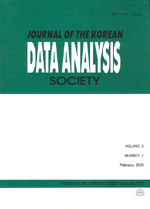우리나라 대도시의 용도지역 특성 분석
The Characteristics Analysis of Zoning in Korean Big Cities
- 한국자료분석학회
- Journal of The Korean Data Analysis Society (JKDAS)
- Vol.10 No.6
-
2008.123487 - 3499 (13 pages)
- 42

용도지역 특성을 파악하기 위하여 2000-2005년을 시계열적으로 분석한 결과, 인구증가에 따라 토지수요가 많아져 도시별로 주거·상업·공업지역이 약간의 증가를 나타내었다. 다음으로 1인당 용도지역면적의 경우 서울, 부산, 광주, 울산, 전주, 포항, 창원 등은 주거·상업·공업지역의 면적이 증가하였고 인천의 경우는 주거·상업·공업지역 면적이 크게 감소하였다. 대구는 주거·공업·녹지지역 면적이 감소하였고, 수원과 부천의 경우는 모든 용도지역 면적이 최소 3.4%에서 최고 26.73%가 감소한 것으로 나타났다. 마지막으로 2000-2005년의 용도지역면적을 군집분석 한 결과 서울을 비롯한 수도권 도시들은 주거·상업·녹지지역의 성격이 강한 것으로 나타났고, 지방도시들은 대부분이 공업지역의 성격이 강한 것으로 나타났다. 이러한 결과를 볼 때 용도별 기능의 편중화로 인하여 지역 불균형이 발생하고 결국 국토의 균형발전에 상당한 영향을 초래하고 있다.
The research has analyzed the situations of Korean cities in sequence from the year of 2000 to the year of 2005 in order to figure out the characteristics of use district. Its result showed some increase of use district in commercial, residential, and industrial area in increasing demand resultied from rising population. The use district per person of residential, commercial, and industrial area somewhat increased in such cities as Seoul, Busan, Gwangju, Ulsan, Cheonju, Pohang, and Changwon, but the area decreased in the city of Incheon. In the city of Daegu the area decreased in residential, commercial, and green ground but all the area of use district decreased from the minimum 3.4% to maximum 26.7% in Suwon and Bucheon. Finally the result from the cluster analysis of use district area from 2000 to 2005 showed residential, commercial, and green area increase in capital outskirt cities as well as is Seoul, but industrial area increase in province cities. As a result, the unbalance of national development has occurred due to the intensified function of specific area, affecting the unbalanced progress of the entire national land. 2000, which results in 200.
1. 서론
2. 자료구축 및 분석방법
3. 이론적 고찰
4. 대도시의 용도지역 특성 분석
5. 결론
참고문헌
(0)
(0)